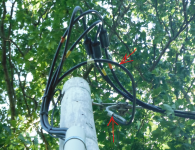Paco Solar
Member, NABCEP Installer
- Location
- Southeastern PA
- Occupation
- Solar Engineer (PE)
Folks,
Background:
I have an existing 3-phase, ground-mtd. PV system in PA, being replaced with a new System, that I am designing now (new Modules and inverters). We are now under NEC 2017.
We'd like to utilize the existing wires (300' underground, then 400' aerial on poles) from the array to the Point of Interconnection (POI).
We are proposing inverters (solaredge 33.3k) that require a 4-wire (wye) service (which we have, at the service). At the transition from Underground to Aerial, the 4 conductors (3 + N) were transitioned to "quad-plex" so the Neutral (messenger) becomes uninsulated, and there is no EGC.
Question:
In order to provide the insulated Neutral conductor, we'd like add a single conductor, strapping it to the existing quadplex "bundle" The Inspector has a feeling that this is not compliant, but is open to us making the case. 300.3 (B) seems to go against this idea, (if the quadplex is considered a "cable") requiring that all conductors of the same circuit be "...contained within the same....cable...". Can anyone think of a Code section that might permit this idea? Has anyone ever seen this done before? Any alternate ideas? (The photo shows the riser pole, where the 4 UG conductors come up the pole and transition to the quadplex.)
Thank you!

Background:
I have an existing 3-phase, ground-mtd. PV system in PA, being replaced with a new System, that I am designing now (new Modules and inverters). We are now under NEC 2017.
We'd like to utilize the existing wires (300' underground, then 400' aerial on poles) from the array to the Point of Interconnection (POI).
We are proposing inverters (solaredge 33.3k) that require a 4-wire (wye) service (which we have, at the service). At the transition from Underground to Aerial, the 4 conductors (3 + N) were transitioned to "quad-plex" so the Neutral (messenger) becomes uninsulated, and there is no EGC.
Question:
In order to provide the insulated Neutral conductor, we'd like add a single conductor, strapping it to the existing quadplex "bundle" The Inspector has a feeling that this is not compliant, but is open to us making the case. 300.3 (B) seems to go against this idea, (if the quadplex is considered a "cable") requiring that all conductors of the same circuit be "...contained within the same....cable...". Can anyone think of a Code section that might permit this idea? Has anyone ever seen this done before? Any alternate ideas? (The photo shows the riser pole, where the 4 UG conductors come up the pole and transition to the quadplex.)
Thank you!


